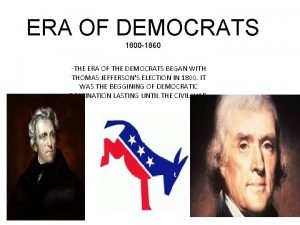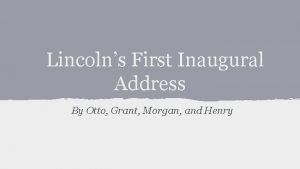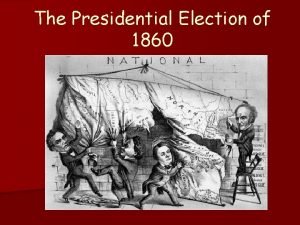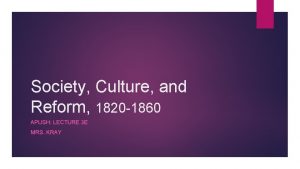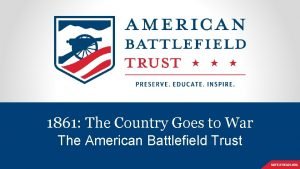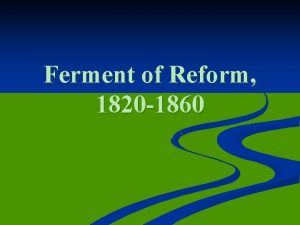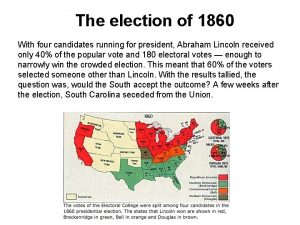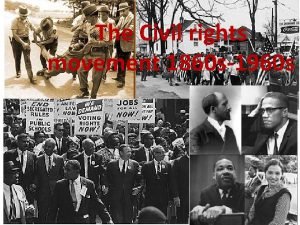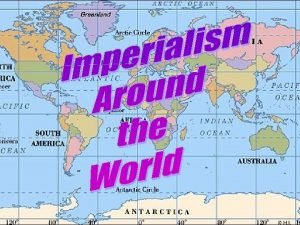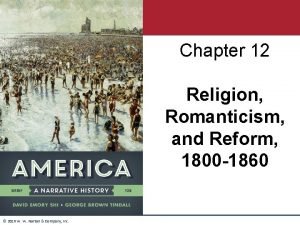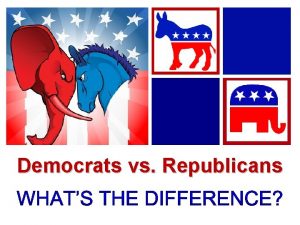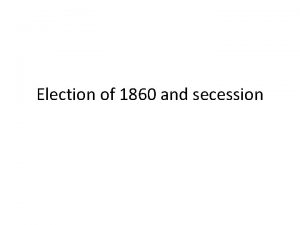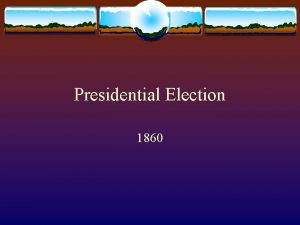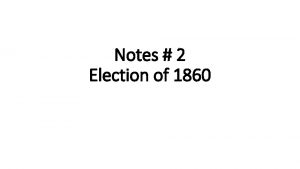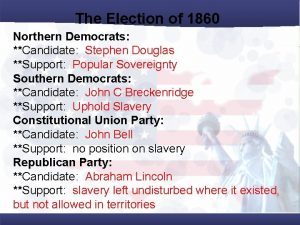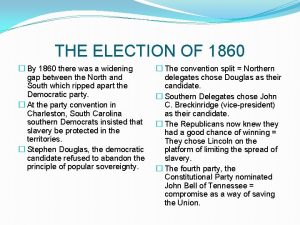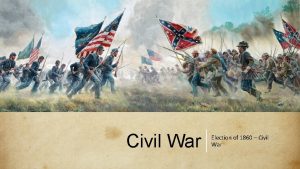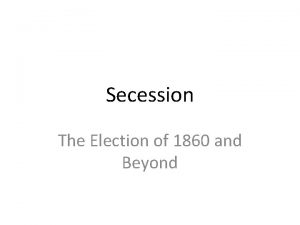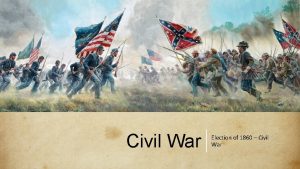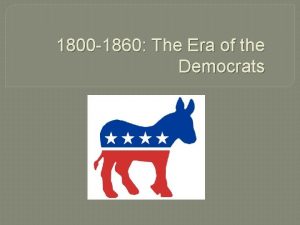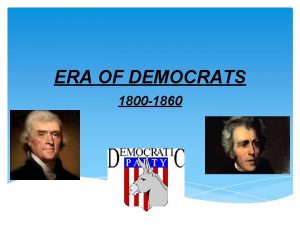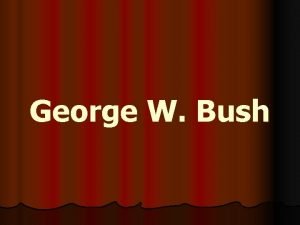Election of 1860 Democrats hold national convention at

















- Slides: 17

Election of 1860 • Democrats hold national convention at Charleston, S. C. – Party is broke, city offered the most money. – City is the heart of the secessionist movement and is experiencing a severe heat wave in April of 1860. – Question is: Should they nominate a candidate 1 st or write the party platform? • Agree to Platform first but can’t decide what it is, finally settle on popular sovereignty.

– Fire-eaters use this issue to strike: William Yancy of Mississippi and Robert Toombs of Georgia led a walkout of delegates from 9 southern states. Why? • Some see it as prelude to secession (cutting ties). • Hope to get Douglas to withdraw by walking out. • Hope to be asked back to force compromise. • Want to destroy the Democratic Party forcing a 3 way election putting it in the hands of the House of Rep.

– After walkout, convention immediately goes into nomination. • Chairman makes ruling that the 2/3 rds rule means all delegates not just those present. • With 9 states missing, 2/3 rds is an impossibility, convention adjourns without a nomination. • Republicans meet in Chicago: Split in Democrats means presidency is within grasp. – Leading contender is William Seward from New York. • Has many enemies. – They need to choose “best available man”.

• Chose Abraham Lincoln of Illinois. Why? – A moderate-few political enemies. – Old line Henry Clay Whig supporting American system and modernization of the economy. – Campaign manager is Judge David Davis, who sold out Lincoln in exchange for jobs. – Republicans believed that Lincoln would be a traditional Whig candidate (figurehead). • Lincoln gets nomination on the 3 rd ballot – ticket balanced by Maine Free. Soiler Hannibal Hamlin.

• Democrats meet again in Baltimore. – Douglas attempted to withdraw, northern supporters do not allow it. – Southern Democratic dissidents then met in Richmond and nominated 39 year old John C. Breckenridge (the Vice-president). • Not in favor of secession and supported by Buchanan. • Constitutional Union Party formed out of remaining Whigs (except Northern Cotton Whigs, who support Lincoln). – Nominate John Bell.

• Two-party system now shattered over extension issue by a four way race. – Fire-eaters make the argument that if the “Black Republican” Lincoln wins, the South must secede.

Election Results Lincoln: 1, 865, 593 (39. 8%); 180 electoral votes. Douglas: 1, 382, 713 (29. 5%); 12 electoral votes. Breckenridge: 848, 713 (18. 1%); 72 electoral votes. Bell: 592, 906 (12. 6%); 39 electoral votes.

Hidden Meaning of Results • Lincoln received 26, 388 votes in the South (not on ballot in 10 Southern states) and came in 3 rd in the border states (Maryland, Missouri, Kentucky and Delaware). • Douglas did well in both sections. • Bell ran well in Upper South (especially Virginia). • Breckenridge (unwilling candidate for secession) did well in South. – Fire-eaters use this as mandate for secession. – In reality it is not a mandate because combining Douglas and Bell it puts him behind by 104, 000 voters.

• Election shows that with all the Fire-eaters have done, they still did not have a mandate. – Really showed hope of compromise among Southern voters – Fire-eaters fear compromise might happen and need to move quickly. – Come up with 3 part plan. • Withdraw as many Southern states as possible. – – – – South Carolina: 12/20/1860. Mississippi: 1/9/1861. Florida: 1/10/1861. Alabama: 1/11/1861. Georgia: 1/19/1861. Louisiana: 1/26/1861. Texas: 2/1/1861.

• Establish a new government: early February 1861. – Drew up Confederate constitution. – Elected temporary president (Jefferson Davis of Mississippi) and vice-president (Alexander Stephens of Georgia). • Keep Southern Congressman in Washington as long as possible to prevent government from reacting.

Was compromise still possible? • Lame Duck president, James Buchanan asked Lincoln what he wished to do, Lincoln gave no response. – Buchanan addressed Congress: • Stated the secession was an impossibility. • But, if a state wants to secede, the federal government could not stop it. • Groups capable of compromise. – Southern Unionists: oppose secession. • Tennessee Senator Andrew Johnson. – Conditional secessionists (Southern Douglas Democrats): hope for compromise based upon Northern concessions. • Also are anti-coercionists who oppose any use of force to maintain Union.

– Moderate Southern Democrats and Cotton Whigs (fence sitters such as Jefferson Davis): fear losing political power and influence to younger generation (Fire-eaters). • Crittenden Compromise. – Congressman John Crittenden of Kentucky lends name to bill forged by the House and Senate (a Congressional plan): December 18, – Had 2 parts. • Binding, unrepealable and unamendable amendments. • Formed as an “omnibus” bill-president must accept entire bill. 1860.

– Proposed amendments. • Guarantee permanence of slavery where it existed. • Prohibit the abolition of slavery in Washington, D. C. unless the voters of Maryland Virginia agree. • Federal government could not abolish slavery in any area it controlled within a state. • No interference in the internal slave trade. • Federal government would compensate slave owners who were prevented by local opposition from recovering escaped slaves. • Extend the Missouri Compromise line (36’ 30”) on territory “now held, or hereafter acquired”, with slavery recognized and protected as property. – Resolutions. • Enforcement of fugitive slave laws. • Condemnation of “personal liberty” laws. • Enforce ban on African slave trade.

– Assumptions about the compromise. • No two-party system to broker compromise. – Politicians, especially Douglas Democrats and Republicans could not back down without looking weak or hypocritical. • The South will try to hold onto the old Calhoun threat of secession and hope for Northern concessions. Which groups could and could not accept? • Could accept. – Constitutional Unionists: intent on saving Union (most are conservative Whigs). – Proslavery elements in the North (old Cotton Whigs and Democrats): good for business, saves the Union and doesn’t upset the status quo. – Southern and Northern Unionists (mainly old Cotton Whigs and Union Whigs): nationalists opposed to secession.

• Who couldn’t accept. – Fire-eaters: threat to secession. – Southern Democratic Moderates: Davis had staked career on slave codes for territories, could not back down. – Douglas Democrats: against the platform of Popular Sovereignty. – Abolitionists: initially accept secession, led by Horace Greeley (editor of the New York Tribune, weekly paper popular across the U. S. , a national paper). • Let the 7 states go, they will come back when they cannot survive without Northern markets. • When they plead to return, then abolish slavery. • Oppose compromise because there is no guarantee that slavery will disappear. – Republicans: threat to containment policy, allows expansion.

Other Attempts at Compromise • “Old Gentleman’s Agreement” (made up of elder statesman): called by John Tyler on Washington’s birthday (2/22/1861), altered version of Crittenden’s Compromise. – Extension of Missouri Compromise line only applied to current territory. – Majority of senators from both free and slave states would have to approve the acquisition of new territory. – Not acceptable to Republicans because it does not guarantee the non-extension of slavery. • William Seward and “Masterly Inactivity”: aimed at conditional unionists in the South. – Do nothing to antagonize Southern conditional unionists and wait for events to develop. – Predicated on the idea that peaceful reunion was possible.

• End of February 1861, a 3 rd compromise appeared based on “Masterly Inactivity”. – Revision of Crittenden’s Compromise dealing with specific issue of slavery. – Congressional leaders, specifically Senator Thomas Corwin of Ohio, proposed (with Lincoln’s approval) a 13 th Amendment. • Would forever prohibit any interference with slavery in the states.
 Era of the democrats 1800-1860
Era of the democrats 1800-1860 Election of 1860 pie chart
Election of 1860 pie chart Election of 1860 definition
Election of 1860 definition American romanticism 1800 to 1860 worksheet answers
American romanticism 1800 to 1860 worksheet answers Rationalism vs romanticism
Rationalism vs romanticism Arthur and lewis tappan apush
Arthur and lewis tappan apush South carolina 1860
South carolina 1860 Border states in 1860
Border states in 1860 American reform movements between 1820 and 1860
American reform movements between 1820 and 1860 Map of 1860
Map of 1860 Decreto 1860 de 1994
Decreto 1860 de 1994 1860
1860 Balais à tapis 1860
Balais à tapis 1860 South africa 1860
South africa 1860 Chapter 12 religion romanticism and reform
Chapter 12 religion romanticism and reform American romanticism 1800 to 1860 worksheet answers
American romanticism 1800 to 1860 worksheet answers American romantic period
American romantic period Cobra election form sample
Cobra election form sample
